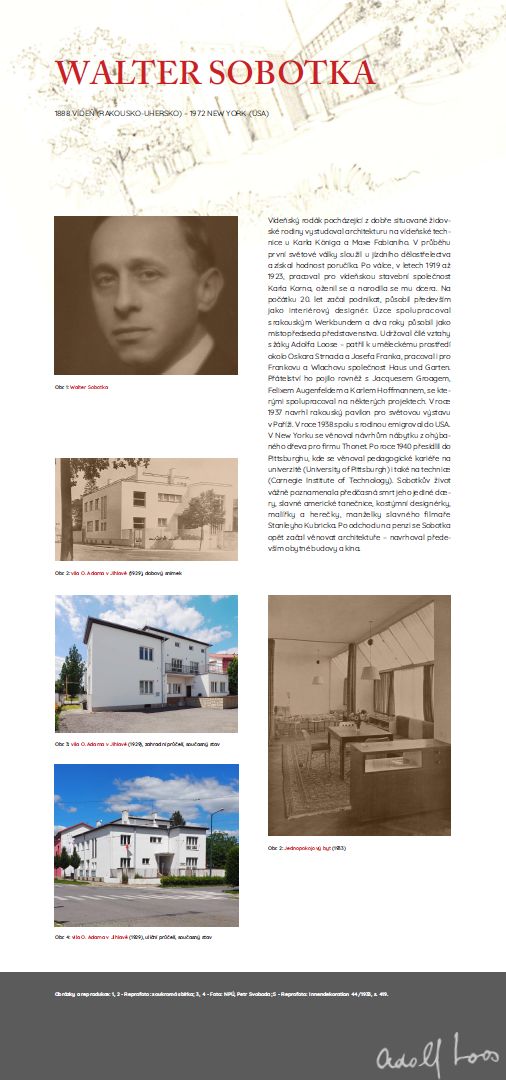Vážení a milí návštěvníci, od 1. do 15. ledna máme zavřeno. Děkujeme vám za přízeň v roce 2025 a přejeme šťastný a úspěšný rok 2026. // Dear visitors, from January 1 to January 15 we will be closed. Thank you for your support in 2025, and we wish you a happy and successful year 2026.
Následovníci Adolfa Loose / Adolf Loos Followers
Virtuální prohlídka výstavy / virtual tour of the exhibition
Titul | Adolf Loos | Felix Augenfeld | Friedrich Ehrmann | Paul Engelmann | Jacques Groag | Alfons Hetmanek | Heinrich Kulka | Karel Lhota | Margarete Schütte-Lihotzky | Walter Sobotka | Kurt Unger | Jan Víšek | Rudolf Wels | Ernst Wiesner
Walter Sobotka
1888 VÍDEŇ (RAKOUSKO-UHERSKO) – 1972 NEW YORK (USA)
|
Vídeňský rodák pocházející z dobře situované židovské rodiny vystudoval architekturu na vídeňské technice u Karla Königa a Maxe Fabianiho. V průběhu první světové války sloužil u jízdního dělostřelectva a získal hodnost poručíka. Po válce, v letech 1919 až 1923, pracoval pro vídeňskou stavební společnost Karla Korna, oženil se a narodila se mu dcera. Na počátku 20. let začal podnikat, působil především jako interiérový designér. Úzce spolupracoval s rakouským Werkbundem a dva roky působil jako místopředseda představenstva. Udržoval čilé vztahy s žáky Adolfa Loose – patřil k uměleckému prostředí okolo Oskara Strnada a Josefa Franka, pracoval i pro Frankovu a Wlachovu společnost Haus und Garten. Přátelství ho pojilo rovněž s Jacquesem Groagem, Felixem Augenfeldem a Karlem Hoffmanem, se kterými spolupracoval na některých projektech. V roce 1937 navrhl rakouský pavilon pro světovou výstavu v Paříži. V roce 1938 spolu s rodinou emigroval do USA. V New Yorku se věnoval návrhům nábytku z ohýbaného dřeva pro firmu Thonet. Po roce 1940 přesídlil do Pittsburghu, kde se věnoval pedagogické kariéře na univerzitě (University of Pittsburgh) i také na technice (Carnegie Institute of Technology). Sobotkův život vážně poznamenala předčasná smrt jeho jediné dcery, slavné americké tanečnice, kostýmní designérky, malířky a herečky, manželky slavného filmaře Stanleyho Kubricka. Po odchodu na penzi se Sobotka opět začal věnovat architektuře – navrhoval především obytné budovy a kina. |
A native of Vienna from a well-to-do Jewish family, he studied architecture at the Vienna Technical University with Karel König and Max Fabiani. During the First World War, he served in the cavalry artillery and gained the rank of lieutenant. After the war, from 1919 to 1923, he worked for the Vienna construction company of Karel Korn, got married and had a daughter. He started a business in the early 1920’s, working mainly as an interior designer. He worked closely with the Austrian Werkbund and served as vice chairman of the board for two years. He maintained a lively relationship with the pupils of Adolf Loos – he belonged to the artistic environment around Oskar Strnad and Josef Frank, and he also worked for Frank and Wlach's company, Haus und Garten. He was also friends with Jacques Groag, Felix Augenfeld and Karel Hoffman, with whom he collaborated on some projects. In 1937, he designed the Austrian pavilion for the World Exhibition in Paris. In 1938 he emigrated with his family to the USA. In New York, he designed bentwood furniture for Thonet. After 1940, he moved to Pittsburgh, where he pursued a teaching career at the University of Pittsburgh and also at the Carnegie Institute of Technology. Sobotka's life was seriously marred by the untimely death of his only daughter, a famous American dancer, costume designer, painter and actress, the wife of the famous filmmaker Stanley Kubrick. After retiring, Sobotka began to focus on architecture again – he mainly designed residential buildings and cinemas. |
